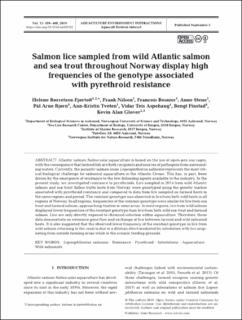| dc.contributor.author | Fjørtoft, Helene Børretzen | |
| dc.contributor.author | Nilsen, Frank | |
| dc.contributor.author | Besnier, Francois | |
| dc.contributor.author | Stene, Anne | |
| dc.contributor.author | Bjørn, Pål Arne | |
| dc.contributor.author | Tveten, Ann-Kristin | |
| dc.contributor.author | Aspehaug, Vidar Teis | |
| dc.contributor.author | Finstad, Bengt | |
| dc.contributor.author | Glover, Kevin | |
| dc.coverage.spatial | Norge, Noreg, Norway, Finnmark, Trøndelag, Møre og Romsdal, Sogn og Fjordane, Hordaland, Rogaland, Agder | nb_NO |
| dc.date.accessioned | 2019-09-10T11:39:44Z | |
| dc.date.available | 2019-09-10T11:39:44Z | |
| dc.date.issued | 2019 | |
| dc.identifier.issn | 1869-215X | |
| dc.identifier.uri | http://hdl.handle.net/11250/2614516 | |
| dc.description.abstract | Atlantic salmon Salmo salar aquaculture is based on the use of open-pen sea cages, with the consequence that farmed fish are both recipients and sources of pathogens from surrounding waters. Currently, the parasitic salmon louse Lepeophtheirus salmonis represents the most Critical biological challenge for salmonid aquaculture in the Atlantic Ocean. This has, in part, been driven by the emergence of resistance to the few delousing agents available to the industry. In the present study, we investigated resistance to pyrethroids. Lice sampled in 2014 from wild Atlantic salmon and sea trout Salmo trutta hosts from Norway were genotyped using the genetic marker associated with pyrethroid resistance and compared to data from lice sampled on farmed hosts in the same regions and period. The resistant genotype was observed in lice from both wild hosts in all regions of Norway. In all regions, frequencies of the resistant genotype were similar for lice fromsea trout and farmed salmon, approaching fixation in some areas. Inmost regions, lice fromwild salmon displayed lower frequencies of the resistant genotype than lice from both wild sea trout and farmed salmon. Lice are only directly exposed to chemical selection within aquaculture. Therefore, these data demonstrate an extensive gene flow and exchange of lice between farmed and wild salmonid hosts. It is also suggested that the observed lower frequency of the resistant genotype in lice from wild salmon returning to the coast is due to a dilution effect mediated by infestation with lice originating from outside farming areas while in the oceanic feeding grounds. | nb_NO |
| dc.language.iso | eng | nb_NO |
| dc.rights | Navngivelse 4.0 Internasjonal | * |
| dc.rights.uri | http://creativecommons.org/licenses/by/4.0/deed.no | * |
| dc.subject | Lepeophtheirus salmonis | nb_NO |
| dc.subject | Resistance | nb_NO |
| dc.subject | Pyrethroid | nb_NO |
| dc.subject | Infestations | nb_NO |
| dc.subject | Aquaculture | nb_NO |
| dc.subject | Wild salmonids | nb_NO |
| dc.title | Salmon lice sampled from wild Atlantic salmon and sea trout throughout Norway display high frequencies of the genotype Associated with pyrethroid resistance | nb_NO |
| dc.type | Journal article | nb_NO |
| dc.rights.holder | © The authors 2019. | nb_NO |
| dc.subject.nsi | VDP::Matematikk og Naturvitenskap: 400::Zoologiske og botaniske fag: 480 | nb_NO |
| dc.source.pagenumber | 459-468 | nb_NO |
| dc.source.volume | 11 | nb_NO |
| dc.source.journal | Aquaculture Environment Interactions | nb_NO |
| dc.identifier.doi | 10.3354/aei00322 | |
| dc.identifier.cristin | 1723276 | |

